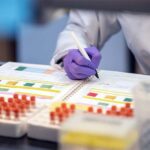What parents should know about hypospadias

It’s one of the most common birth defects, affecting an estimated 1 out of 200 boys. But most parents aren’t aware of hypospadias until their child is diagnosed with it. In this condition, the opening of a boy’s urethra (through which both urine and semen pass) is located on the underside of his penis rather than at the tip of it. In about 80 percent of boys with hypospadias, this opening is found near the end of the penis. Fifteen percent of those boys also have a condition called chordee, in which the penis curves downward to varying degrees. Hypospadias is usually diagnosed at birth, but severe cases are increasingly being diagnosed in utero with ultrasonography.
Fortunately, hypospadias can be easily corrected through outpatient surgery, explains Dr. Carlos Estrada, a physician in the Department of Urology at Boston Children’s Hospital. Here, he answers some common questions that parents ask about hypospadias.
What causes hypospadias?
Hypospadias is a congenital condition, which means that it develops while your baby is still in the womb. It isn’t clear what causes hypospadias, although its incidence has been increasing over the past several decades. There does seem to be a genetic link: The condition appears to be slightly more common in boys whose father or brother also had it.
What are the treatment options?
Treatment may not be necessary for boys with very mild forms of hypospadias that are unlikely to interfere with normal functioning. However, most children with hypospadias will require treatment — without it, they may experience urinary and sexual difficulties later in life.
“The goals of treatment are to reposition the opening of the urethra, straighten the penis if necessary and improve its outward appearance,” says Dr. Estrada. “Surgery remains the only way to permanently correct hypospadias.”
What does surgery involve?
Unless hypospadias is very severe, surgery to correct it usually only lasts about one to two hours and ideally takes place when a boy is 6 to 12 months old. It is performed under general anesthesia, and most children get to go home the same day. To keep the new urethra open as it heals, the doctor will leave a soft drainage catheter in place for about a week. Your child’s care team will instruct you on how to care for all aspects of his recovery at home.
Can boys with hypospadias be circumcised?
In many boys with hypospadias, the foreskin (the fold of skin covering the tip of the penis, or glans) also doesn’t develop properly, resulting in extra foreskin on the top of the penis and none on the underside. This can affect how and when your son is circumcised — the foreskin may be needed for the repair, for example.
Will it affect potty training?
Many parents worry that hypospadias and the surgery to correct it might interfere with the potty-training process. Because the best window for hypospadias surgery is between the ages of 6 and 12 months old, your son will be healed well before potty training begins.
Will it affect future sexual function?
No. Once the problem is repaired, he shouldn’t experience any future sexual dysfunction due to hypospadias.
Learn about the Department of Urology.
Related Posts :
-

Parsing the promise of inosine for neurogenic bladder
Spinal cord damage — whether from traumatic injury or conditions such as spina bifida — can have a profound impact on bladder ...
-

Modeling urinary tract disorders on a chip: Zohreh Izadifar
When a new tissue sample arrives from the Department of Urology, the Boston Children’s Hospital lab of Zohreh Izadifar, ...
-

Helping manage ‘sensitive issues’: How our psychosocial team helps kids with urologic concerns
In Boston Children’s Department of Urology, urologists, pediatricians, and nurses aren’t the only ones who care for kids ...
-

Making a change: After a second opinion for spina bifida care, Sydney is thriving
At almost 10 years old, Sydney MacKay is sassy, spunky, and wants to be as independent as possible. Because she was ...





